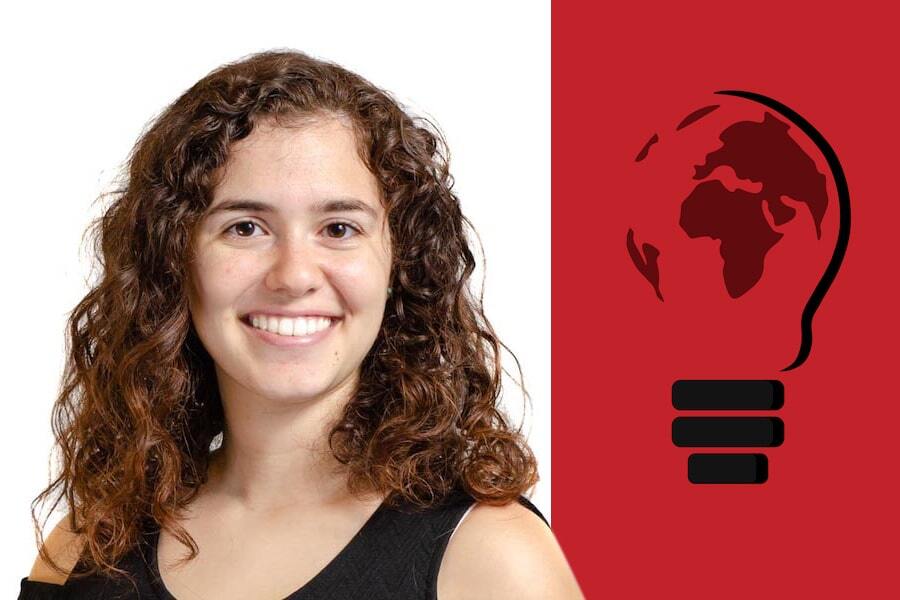
Habbab Turned Adversity Into Opportunities for Good
“COVID Squad” of Students Fanned Out to Help
By Katy Rank Lev
Like many Carnegie Mellon University students last spring, Tala Habbab was scrambling to find an internship. With much of the world moved to remote operations, pickings were slim, but as a master's degree student in the Integrated Innovation Institute, she was required to complete a summer internship.
"Not to sound too cheesy, but I wanted to do something more impactful than just busywork," Habbab said. "I kept hearing the same thing from my friends, all struggling to find internships and also feeling a deep desire to help in some way."
A native of Jordan, Habbab saw a lot of challenges in the Pittsburgh community as a direct result of pandemic disruption. She felt there must be something bright college students could do to advance their skills with practical experience and put their minds to work toward real societal problems.
She envisioned a "COVID squad" of students who could brainstorm ideas to support communities impacted by the virus. Habbab reached out to Michael Murphy, distinguished service professor and executive director of the Center for Leadership Studies, who taught the leadership class Habbab took as an undergraduate student majoring in materials science and biomedical engineering. Murphy helped connect her with Student Leadership, Involvement, and Civic Engagement (SLICE).
“Tala is such a moving exemplar of what Carnegie Mellon students do,” Murphy said, “which is to translate their vision and values into profound action — not simply lament the reality of hardship and challenge, but turn them into the opportunity to lead positive change in people’s lives in their time of need.”
Elizabeth Vaughan, associate dean of Student Affairs and director of SLICE, was delighted to learn of Habbab’s creative internship alternative and offered to help. SLICE had been working to create new programming that would allow CMU students opportunities for civic engagement without an in-person component.
"Tala created an entire organizational structure to support her project," Vaughan said. "Given the incredible scope and student-led nature of the project, we enthusiastically embraced the opportunity to provide advising support, connect the students to relevant campus and community partners, and shift financial resources to support it."
When Habbab put together a social media post to sniff out interested students, she hoped she'd get 50 by the end of May. She had 50 responses that same day and eventually amassed 400 interested students from around the world, including CMU-Qatar and Silicon Valley students.
“Tala is such a moving exemplar of what Carnegie Mellon students do, which is to translate their vision and values into profound action.” — Michael Murphy
Habbab was able to accept 250 students and divided them into 45 teams focused on one of six action areas: economic impact, medical impact, educational quality and access, food insecurity, environmental impact or social impact. Habbab named her initiative The COVID-19 Innovation Project, and modeled the project’s structure after the methodology for project management she learned in her master's degree capstone course.
She organized informational lectures to help students move their projects through problem identification, solution development and solution implementation.
"All of the student projects were unique," Habbab said, noting that some of the participating students served with her in an executive role to help manage the 45 project teams, coordinate lectures and coach students through practical skills like developing budgets or using industry standards for research methods and building community partnerships.
The COVID-19 Innovation Project transitioned to its solution implementation phase in August. One local team from the Pittsburgh campus was refining a project for the CMU Pantry. Project students worked with Pantry Coordinator Zachary Miller on an inventory management system that they hope to link to an online order form.
Another team met weekly with Jim McMillan, chief engineer with the National Renewable Energy Laboratory, to discuss bio-energy policy. With vehicle emissions likely to rise again as COVID-19 travel restrictions ease, McMillan helped the students define feasible goals to deliver policy memos to lawmakers.
Vaughan was impressed and encouraged by the teams' final project presentations.
"This project was born out of students having lost opportunities and had their summer plans turned upside-down," she said. "What emerged was a tremendous amount of learning, relationship building and perspective gained from community partnerships."
"I was trying to find some way to combine everyone's skills and passions when we are all feeling kind of helpless," Habbab said. "SLICE took a huge leap of faith trusting me with this project, and I'm so grateful I was able to bring all these minds together."
